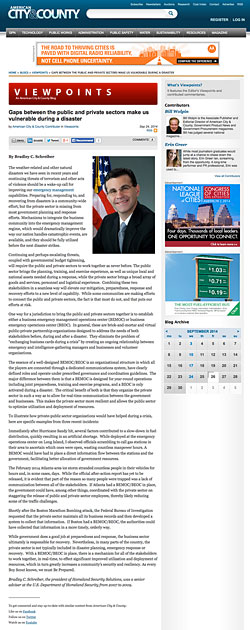September 24, 2014
|
Gaps between the public and private sectors make us vulnerable during a disaster By: Bradley C. Schreiber
Continuing and perhaps escalating threats, coupled with governmental budget tightening, will require the public and private sectors to work together as never before. The public sector brings the planning, training, and exercise experience, as well as unique local and national assets needed during a response, while the private sector brings a broad array of goods and services, personnel and logistical experience. Combining these two stakeholders in a seamless way will elevate our mitigation, preparedness, response and recovery efforts to a new level of capability. While some communities are making efforts to connect the public and private sectors, the fact is that most do not, and that puts our efforts at risk. One way for a jurisdiction to bring the public and private sectors together is to establish either a business emergency management operations center (BEMOC) or business emergency operations center (BEOC). In general, these are brick-and-mortar and virtual public-private partnership organizations designed to address the needs of both stakeholders before, during and after a disaster. They eliminate the problem of “exchanging business cards during a crisis” by creating an ongoing relationship between emergency and intelligence-gathering managers and businesses and volunteer organizations. The essence of a well-designed BEMOC/BEOC is an organizational structure in which all the players are connected through a dedicated communications system, have clearly defined roles and operate under prescribed governance and coordination guidelines. The major difference between them is that a BEMOC is designed for year-round operations including joint preparedness, training and exercise programs, and a BEOC is only activated during a disaster. The critical benefit of both is that they organize the private sector in such a way as to allow for real-time communication between the government and businesses. This makes the private sector more resilient and allows the public sector to optimize utilization and deployment of resources. To illustrate how private-public sector organizations would have helped during a crisis, here are specific examples from three recent incidents: The February 2014 Atlanta-area ice storm stranded countless people in their vehicles for hours and, in some cases, days. While the official after-action report has yet to be released, it is evident that part of the reason so many people were trapped was a lack of communication between all of the stakeholders. If Atlanta had a BEMOC/BEOC in place, the government could have, among other things, coordinated with the private sector on staggering the release of public and private sector employees, thereby likely reducing some of the traffic challenges. Shortly after the Boston Marathon Bombing attack, the Federal Bureau of Investigation requested that the private sector maintain all its business records and then developed a system to collect that information. If Boston had a BEMOC/BEOC, the authorities could have collected that information in a more timely, orderly way. While government does a good job at preparedness and response, the business sector ultimately is responsible for recovery. Nevertheless, in many parts of the country, the private sector is not typically included in disaster planning, emergency response or recovery. With a BEMOC/BEOC in place, there is a mechanism for all of the stakeholders to work together, in real-time, to effect significant improved utilization and deployment of resources, which in turn greatly increases a community’s security and resiliency. As every Boy Scout knows, we must Be Prepared. Bradley C. Schreiber, the president of Homeland Security Solutions, was a senior adviser at the U.S. Department of Homeland Security from 2007 to 2009. |


 The weather-related and other natural disasters we have seen in recent years and continuing threats of terrorism and other acts of violence should be a wake-up call for improving our emergency management capabilities. Preparing for, responding to, and recovering from disasters is a community-wide effort, but the private sector is missing from most government planning and response efforts. Mechanisms to integrate the business community into the emergency management regime, which would dramatically improve the way our nation handles catastrophic events, are available, and they should be fully utilized before the next disaster strikes.
The weather-related and other natural disasters we have seen in recent years and continuing threats of terrorism and other acts of violence should be a wake-up call for improving our emergency management capabilities. Preparing for, responding to, and recovering from disasters is a community-wide effort, but the private sector is missing from most government planning and response efforts. Mechanisms to integrate the business community into the emergency management regime, which would dramatically improve the way our nation handles catastrophic events, are available, and they should be fully utilized before the next disaster strikes.